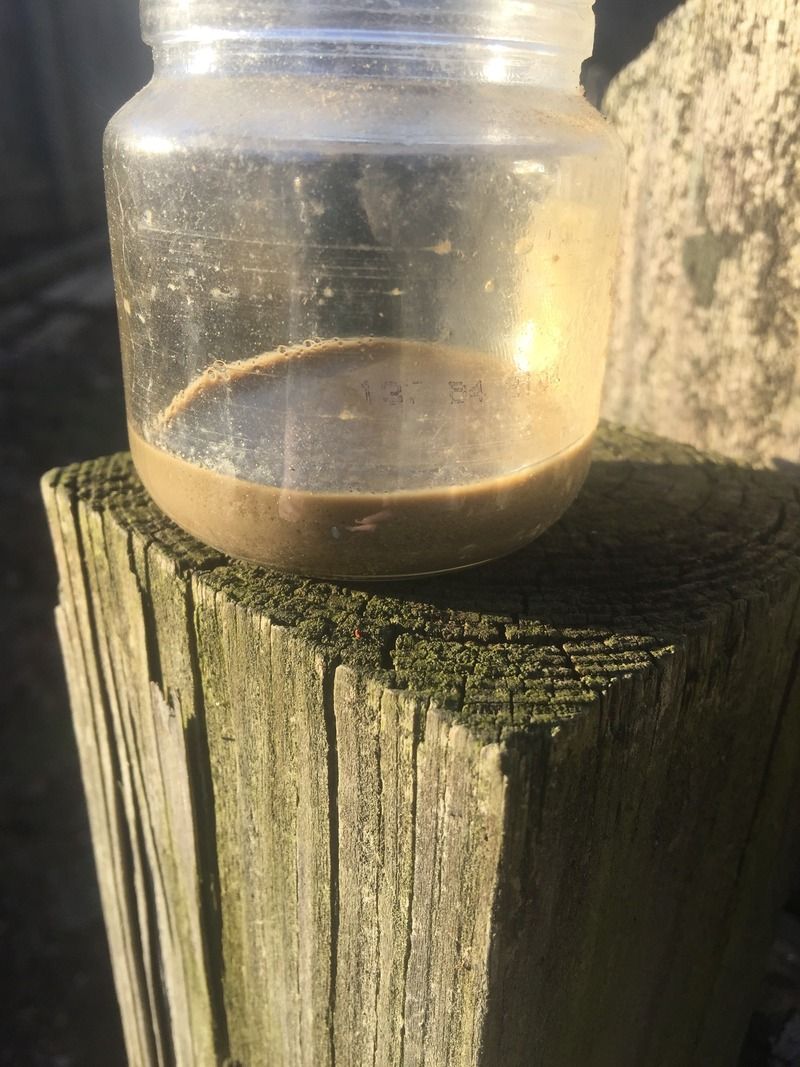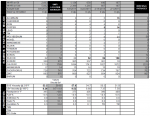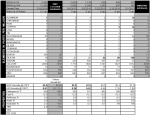-
Sign Up! To view all forums and unlock additional cool features
Welcome to the #1 Fiesta ST Forum and Fiesta ST community dedicated to Fiesta ST owners and enthusiasts. Register for an account, it's free and it's easy, so don't hesitate to join the Fiesta ST Forum today!
Used Oil Analysis Reports
- Thread starter BeansNCornbread
- Start date
I changed my oil out the 1st time at 550 miles and to Amsoil 0w-30 full syn plus their EA filter, and I just changed it out for the 2cd time at 3500 miles this past weekend using the same type oil & filter.
I have a Tune+ 93 octane tune, and will sample my oil at my next change which I will be extending to a 3500 mile OCI. I use this car for weekends and fun only, so I'm pretty strong with the throttle once it's properly warmed up, and I am curious after reading through this thread to see what my next oil change will have to say about engine wear and oil quality.
I went with the 0w-30 for better flow at cold startup and specifically for the turbo, and I am curious what the viscosity will be after 3500 miles of repeated 25 psi max boost runs. Expect my results by this summer if my driving habits stay the same.
I have a Tune+ 93 octane tune, and will sample my oil at my next change which I will be extending to a 3500 mile OCI. I use this car for weekends and fun only, so I'm pretty strong with the throttle once it's properly warmed up, and I am curious after reading through this thread to see what my next oil change will have to say about engine wear and oil quality.
I went with the 0w-30 for better flow at cold startup and specifically for the turbo, and I am curious what the viscosity will be after 3500 miles of repeated 25 psi max boost runs. Expect my results by this summer if my driving habits stay the same.
Thread Starter
#107
I changed my oil out the 1st time at 550 miles and to Amsoil 0w-30 full syn plus their EA filter, and I just changed it out for the 2cd time at 3500 miles this past weekend using the same type oil & filter.
I have a Tune+ 93 octane tune, and will sample my oil at my next change which I will be extending to a 3500 mile OCI. I use this car for weekends and fun only, so I'm pretty strong with the throttle once it's properly warmed up, and I am curious after reading through this thread to see what my next oil change will have to say about engine wear and oil quality.
I went with the 0w-30 for better flow at cold startup and specifically for the turbo, and I am curious what the viscosity will be after 3500 miles of repeated 25 psi max boost runs. Expect my results by this summer if my driving habits stay the same.
I have a Tune+ 93 octane tune, and will sample my oil at my next change which I will be extending to a 3500 mile OCI. I use this car for weekends and fun only, so I'm pretty strong with the throttle once it's properly warmed up, and I am curious after reading through this thread to see what my next oil change will have to say about engine wear and oil quality.
I went with the 0w-30 for better flow at cold startup and specifically for the turbo, and I am curious what the viscosity will be after 3500 miles of repeated 25 psi max boost runs. Expect my results by this summer if my driving habits stay the same.
Probably nothing wrong with the 0w30 but in your climate you will realize zero benefit from the cold flow advantage. Only once you get to -35C would the 0w show any advantage over 5w. The VII's may improve ring seal though mitigating blow by according some papers out there. Or the VII's may exacerbate intake/valve deposits associated with DI the internet is abuzz with.
Thread Starter
#109
OCC is dealing with any blow by, and I look forward to seeing the reports. I like this thread, and the oil tells all....
OCC catches oil vapors form the PCV function. Blow by past the rings is from the down stroke post ignition. So, the significantly heavier molecular weight of the VII's has been shown to have an overpowering affect on the gasses being pushed past the rings and into the crankcase. This theoretically reduces what might be collected in the OCC and on the very optimistic side enhances efficiency through increased compression. With the 0w30 you would be getting more VII's to enhance this benefit while possibly increasing the likely hood of intake fouling depending on the efficiency of the OCC and the VII type. There is debate as to the efficacy of the OCC in mitigating intake valve deposits and evidence supporting that any benefit is nil. Not to say the 0w30 is a bad choice or the use of an OCC is unnecessary. Just other things worth considering in light of the negated cold flow benefit of 0w30 in your situation.
Here is what my OCC caught at 1k miles. Oil was changed at 500 along with the installation OCC - OCC emptied at 1.5k miles.


After settling for around 4 days strong smell of fuel at first - cold weather driving as low as 8 degrees f. Oil on the dip stick seems clean. Going to do an oil change which was planned for 1500 miles anyway. Car has been driven gently for break in. Thoughts?


After settling for around 4 days strong smell of fuel at first - cold weather driving as low as 8 degrees f. Oil on the dip stick seems clean. Going to do an oil change which was planned for 1500 miles anyway. Car has been driven gently for break in. Thoughts?
Thread Starter
#112
Here is what my OCC caught at 1k miles. Oil was changed at 500 along with the installation OCC - OCC emptied at 1.5k miles.


After settling for around 4 days strong smell of fuel at first - cold weather driving as low as 8 degrees f. Oil on the dip stick seems clean. Going to do an oil change which was planned for 1500 miles anyway. Car has been driven gently for break in. Thoughts?


After settling for around 4 days strong smell of fuel at first - cold weather driving as low as 8 degrees f. Oil on the dip stick seems clean. Going to do an oil change which was planned for 1500 miles anyway. Car has been driven gently for break in. Thoughts?
To your results; from my experience it can take 5,000 to 50,000 miles for the fuel dilution to resolve itself. My cars ECUs seem to have run very rich when new or reset causing excessive blow by of fuel to the crankcase that vents through the PCV and as you see into your OCC. I wouldn't sweat it and as you pointed out the cold weather can make it hard for the blow by to be boiled out of the oil. If you are concerned change the oil more often, but as you can see with the limited UOA's we have here these engines appear to be easy on oil so even with the fuel you are probably fine leaving it alone.
Thread Starter
#115
Here is my latest. Included in the total 6,304 miles on this sample are 10 track days worth 931 miles. Oil used was Motorcraft Synthetic Blend 5w30, which was used for a double flush to clean out the Valvoline additives so the UOA was as objective as possible. Sodium is rumored to compete with Boron and Moly too. No tune, but I am now mixing 91AKI with E-85 (E-70 in winter) to stay around 93AKI which works out to E-23-25 usually.
Attachments
-
105.9 KB Views: 125
Wear is usually indicated over a long span of time via these analysis'. Of course if you have only done a couple UOA's you probably won't see any indications of wear.
UOAs are basically there to keep tabs on what your engine and doing. Blackstone in particular is good about giving you a heads up if metals, coolant or gasoline get to excessive levels.
UOAs are basically there to keep tabs on what your engine and doing. Blackstone in particular is good about giving you a heads up if metals, coolant or gasoline get to excessive levels.
Thread Starter
#119
^^^
Takes lots of trending before anything like that is revealed, if ever. That said UOA's aren't the best way to identify wear overall, but rather ascertain the condition of the oil and any underlying issues like coolant or fuel in the oil as noted above. A good example where the UOA fails in wear identification is a lot of GM engines that through metal like no one's business yet last just as long as any other OEM. But, if you suddenly see a lot of copper or lead and verify those aren't from additives or fuel you have a good indication of a bearing issue. Or if you have an AUDI RS4 with the alusil block and you throwing a lot of aluminum with silicon you may a combustion chamber/piston ring/rod issue. If in that example if you have a lot of silicon without the aluminum you probably have an intake leak or are using an engine oil like Motul that uses a larger slug to counter cavitation. The latter you'd verify with a Virgin Oil Analysis of the unused oil. Or you are taking your first UOA on a new engine that's got all that crap in it from being assembled.
Takes lots of trending before anything like that is revealed, if ever. That said UOA's aren't the best way to identify wear overall, but rather ascertain the condition of the oil and any underlying issues like coolant or fuel in the oil as noted above. A good example where the UOA fails in wear identification is a lot of GM engines that through metal like no one's business yet last just as long as any other OEM. But, if you suddenly see a lot of copper or lead and verify those aren't from additives or fuel you have a good indication of a bearing issue. Or if you have an AUDI RS4 with the alusil block and you throwing a lot of aluminum with silicon you may a combustion chamber/piston ring/rod issue. If in that example if you have a lot of silicon without the aluminum you probably have an intake leak or are using an engine oil like Motul that uses a larger slug to counter cavitation. The latter you'd verify with a Virgin Oil Analysis of the unused oil. Or you are taking your first UOA on a new engine that's got all that crap in it from being assembled.
thanks guys, my limited UOA understanding came from a trucking company that used oil analysis to predict major service in diesels that typically ran around 500K miles before opening them up, learning what they could diagnose from UOA surprised me. But that was 20 years ago, oil and engines are better now. Still amazing to me how much longer new engines stay strong with valve guides, bearings and rings. Maybe our engines have 200K+ in them with reasonable maintenance.



